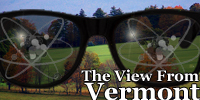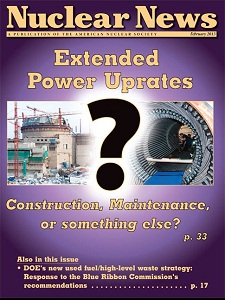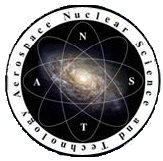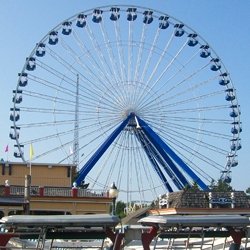Carnival of Nuclear Energy 146
 The 146th Edition of the Carnival of Nuclear Energy is up right now at Next Big Future. You can click here to check it out.
The 146th Edition of the Carnival of Nuclear Energy is up right now at Next Big Future. You can click here to check it out.
The ANS Nuclear Cafe is a blog owned and edited by the American Nuclear Society. Information contained on the ANS Nuclear Cafe has been provided by numerous sources. Therefore, the American Nuclear Society assumes no responsibility or liability for the accuracy of information contained herein. DISCLAIMER: The views expressed in posted articles do not necessarily reflect the views of the American Nuclear Society. The views expressed here are those of the individual authors. ANS takes no ownership of their views. The American Nuclear Society assumes no responsibility or liability for any use or operation of any methods, products, instructions, or ideas contained on this site.

A message from Chapman Nuclear
New Lattice Confinement Fusion Power Reactors May Eliminate 95% of SNF
 The 146th Edition of the Carnival of Nuclear Energy is up right now at Next Big Future. You can click here to check it out.
The 146th Edition of the Carnival of Nuclear Energy is up right now at Next Big Future. You can click here to check it out.
Taxpayers for Common Sense on February 27 issued a press release targeting the Department of Energy for "wasting more than half a billion dollars" on its small modular reactor (SMR) development cost-sharing program. Leaving aside the historically essential role of government investment in developing, advancing, and bringing to market innovative energy technologies-and the fact that early government investments in nuclear energy technology now pay back enormous dividends to all Americans in billions of dollars' worth of affordable and emission-free electricity generation every year-many of the advantages of advanced SMR energy technologies were overlooked or misconstrued in the group's press release and policy brief.
All forms of electricity generation have their own set of advantages... But among the seemingly endless unique advantages of nuclear fission are the massive implications of the deceptively simple equation E=mc². This translates to unparalleled energy density.
The approach of the second anniversary of the Great East Japan Earthquake of March 2011 finds nuclear energy in Japan at a crossroads. After the quake and resulting tsunami, the nuclear plants in Japan that did not shut down immediately eventually all had to shut down for their required, scheduled outages. Political pressures, for the most part, prevented any near-term chance of any of them restarting, it seemed at the time. When Tomari Unit 3 shut down in May 2012, Japan found itself with not one single operating nuclear power plant for the first time in decades. Since that time, only two nuclear units have restarted-Ohi Units 3 and 4 in July 2012. Other plants, rumored to be "next" to start up, have still not started up, although they may soon. The question that springs to mind is naturally, "When will the majority of the plants be allowed to restart?" The more insightful question, though, is, "What will have to be done in order to allow any plant to restart?" And how can we tell which will start first-is there any clue present now? Yes, there is.
 Refueling optimism
Refueling optimism
 The February issue of Nuclear News magazine is available in hard copy and electronically for American Nuclear Society members (click 'ANS Members' or 'Subscribers' in left column). Don't let a month go by without your Nuclear News!
The February issue of Nuclear News magazine is available in hard copy and electronically for American Nuclear Society members (click 'ANS Members' or 'Subscribers' in left column). Don't let a month go by without your Nuclear News!
 The 145th edition of the Carnival of Nuclear Energy is up right now at Atomic Power Review; click here to get there.
The 145th edition of the Carnival of Nuclear Energy is up right now at Atomic Power Review; click here to get there.
All ages are welcome at the Friday Nuclear Matinee for this short video from the UK. Kids get in free! Also, adults who enjoy British accents-and cartoons-and the funny word "aluminium."
 Owners of the (556 MW) Kewaunee nuclear plant in Wisconsin recently announced that they will be closing the plant, because it was losing money and they were unable to find another company willing to buy it.
Owners of the (556 MW) Kewaunee nuclear plant in Wisconsin recently announced that they will be closing the plant, because it was losing money and they were unable to find another company willing to buy it.
 Cassini-Huygens is a Flagship-class NASA-ESA-ASI robotic spacecraft sent to the Saturn system. It has studied the planet and its many natural satellites since its arrival there in 2004, as well as observing Jupiter and the Heliosphere, and testing the theory of relativity. Launched in 1997 after nearly two decades of gestation, it includes a Saturn orbiter Cassini and an atmospheric probe/lander Huygens that landed in 2005 on the moon Titan. Cassini is the fourth space probe to visit Saturn and the first to enter orbit, and its mission is ongoing as of 2013. It is powered by a plutonium power source, and has facilitated many landmark scientific discoveries in its mission to the stars.
Cassini-Huygens is a Flagship-class NASA-ESA-ASI robotic spacecraft sent to the Saturn system. It has studied the planet and its many natural satellites since its arrival there in 2004, as well as observing Jupiter and the Heliosphere, and testing the theory of relativity. Launched in 1997 after nearly two decades of gestation, it includes a Saturn orbiter Cassini and an atmospheric probe/lander Huygens that landed in 2005 on the moon Titan. Cassini is the fourth space probe to visit Saturn and the first to enter orbit, and its mission is ongoing as of 2013. It is powered by a plutonium power source, and has facilitated many landmark scientific discoveries in its mission to the stars.
 ANS Nuclear Cafe is very proud to host this week's Carnival of Nuclear Energy. This weekly feature showcases the best English-language pro-nuclear blogs and articles, and gives a snapshot of what the most experienced and outspoken nuclear advocates feel are the top issues of the times. This week, as with all of the others, there's plenty of variety in the breadth of topical material.
ANS Nuclear Cafe is very proud to host this week's Carnival of Nuclear Energy. This weekly feature showcases the best English-language pro-nuclear blogs and articles, and gives a snapshot of what the most experienced and outspoken nuclear advocates feel are the top issues of the times. This week, as with all of the others, there's plenty of variety in the breadth of topical material.
The ANS Nuclear Cafe today brings faithful viewers a short interview with Dr. Joseph M. Zawodny, senior research scientist at NASA Langley Research Center. Zawodny discusses research on "Low Energy Nuclear Reactions" at NASA Langley, and the incredible potential of this new form of nuclear power-IF theory is validated by experimental results.
 Significant discussions have occurred recently on various internet venues about "load following"-that is, the capability of a generating source to adjust its power output to match variable demands. There is a myth spreading that nuclear power plants cannot load follow, and today's ever-changing discussion about low-GHG generating sources demands that this myth be dispelled.
Significant discussions have occurred recently on various internet venues about "load following"-that is, the capability of a generating source to adjust its power output to match variable demands. There is a myth spreading that nuclear power plants cannot load follow, and today's ever-changing discussion about low-GHG generating sources demands that this myth be dispelled.
Here are some new products available from the American Nuclear Society. Keep your library current-please order today!
or: When nuclear supporters are their own worst enemies
 The 143rd edition of the Carnival of Nuclear Bloggers is up right now at 'The Hiroshima Syndrome.' Click here to access this latest version, contained in the "Fukushima Accident Updates" / blog section of the site.
The 143rd edition of the Carnival of Nuclear Bloggers is up right now at 'The Hiroshima Syndrome.' Click here to access this latest version, contained in the "Fukushima Accident Updates" / blog section of the site.
There have been some significant developments in a number of ongoing news stories this week; we'll touch on three highlights in this wrap-up.
 The February 2013 edition of the technical journal Nuclear Technology (NT) is available electronically and in hard copy for American Nuclear Society member subscribers and others.
The February 2013 edition of the technical journal Nuclear Technology (NT) is available electronically and in hard copy for American Nuclear Society member subscribers and others.
Environmentalist Stewart Brand, one of the principal founders of the green movement in the United States, speaks on environmentalism and nuclear energy. Take a look and have a listen!